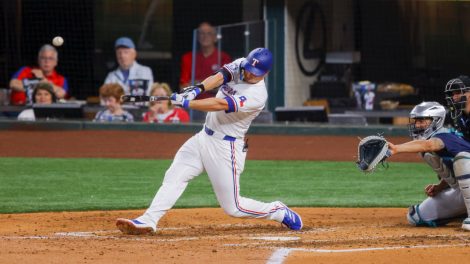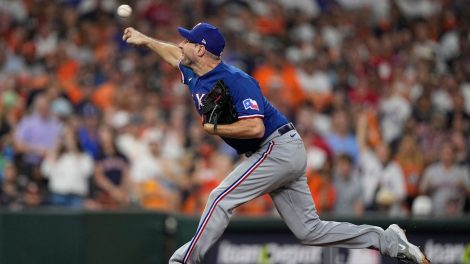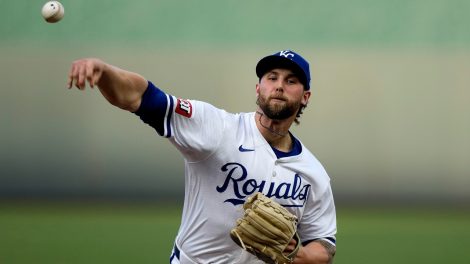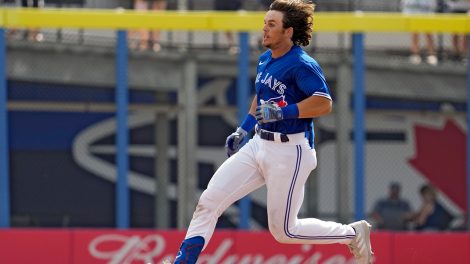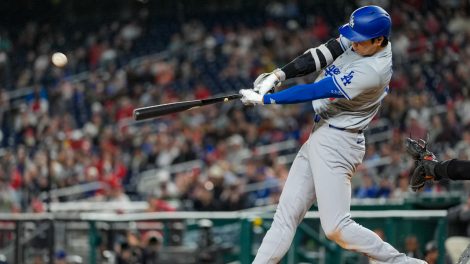Colby Rasmus stood in for the second time against Cole Hamels Tuesday night—feet way up in the box, hands out so far they’re practically in front of the catcher’s face, as he does—and took a slow, fading changeup on the inside of the plate. A first pitch changeup for a strike often means a fastball is on the way, which is good news if you’re Colby Rasmus because Colby Rasmus really likes his fastballs.
Sure enough, Hamels followed with his heater—not a poorly located pitch, right along the bottom of the strike zone—and sure enough Rasmus was waiting on it, starting his swing before Hamels could even finish his follow through.
Rasmus golfed it more than he hit it and the ball made that sound off the bat that makes you immediately look up and out to the bleachers when you hear it because that’s the only place it could’ve gone. His eighth homer of the season landed in the seats more than 400 feet away.
Sometimes in baseball things happen exactly the way you want them to. You get exactly the pitch you’re looking for and you read it so well that the rest of the process is just muscle memory. There’s no thinking; just execution of something you’ve practiced so many times before. But more often than not in the game, things don’t go the way you’d like. And that’s an experience Rasmus can tell you all about.
Through his ups and downs in St. Louis and his further ups and downs in Toronto it’s become incredibly clear what you’re going to get with Rasmus playing centre field every day. Excellent defence; streakiness at the plate. This is how it’s going to be.
The 2014 season has been no different as Rasmus got off to a dreadful start with just two hits in his first 30 plate appearances before clubbing 11 in his next 30. He struggled shortly after that and now finds himself producing again with four homers in his last six games. He has nine hits and two walks in 26 plate appearances over that span. He’s a peaks and valleys kind of guy if there ever was one.
And that’s totally fine, for each of these streaks are just trees in the forest. Long, bitter colds followed by bursts of intense hot that all add up at the end of the season to form a reasonably productive year. Rasmus went through some serious funks at the plate in 2013 and missed significant time due to injury, yet still finished the season worth 4.6 wins above replacement. Streakiness is not necessarily a bad thing.
Remember, it’s not just common for a player like Rasmus to go through this—it’s common for any baseball player, period. There are so few people in this game who can consistently produce night after night, week after week, month after month. Melky Cabrera looks like one a lot of the time. But then you scan up a line on his baseball-reference page to 2013 when a back tumour robbed him of that ability. Even Miguel Cabrera, the best hitter in the game according to those who play it, hit a slump—by his standards, at least—at the end of last season and into the playoffs as nagging injuries caught up to him. It’s just so hard to be so good for so long.
Of course, there are fairly obvious reasons why Rasmus wasn’t having success early on this season. He’s been swinging more (47.5% of the time in 2014 vs. 44.4% last year) and making less contact (a 73.5% contact percentage in 2013 has dropped to 67.5% in 2014). Marry that with the fact he’s seeing fewer pitches in the strike zone (42.3% in 2014 vs. 45.5% in 2013) and swinging at more pitches outside the zone (33.9% in 2014, 29.7% in 2013), and it paints a pretty clear picture of a guy trying to put the bat on pitches he shouldn’t. That’s a rather easy fix and one Rasmus has clearly been attending to as he’s hit as many home runs in his last six games as he did in the 26 prior.
Still, it often seems like fans are searching for reasons not to like Rasmus. Both he and Brett Lawrie started the season in prolonged slumps at the plate (Rasmus, 7-for-42; Lawrie, 4-for-44) while providing stellar defence behind Blue Jays pitchers. They were essentially the same guy, except one played third and the other centre field. But Rasmus heard boos at the Rogers Centre and Lawrie did not. Rasmus was derided on social media and Lawrie was not.
It’s tough to say why. It might have to do with the fact that Rasmus is about as gregarious as wallpaper when he’s in front of a camera. When you talk to him privately you find he’s friendly and funny and a little bit weird in a truly endearing way. But he can be quiet and cold in televised interviews, which has given some fans a false idea that he’s not the most passionate guy.
Which must be one of the weirdest things about being a professional athlete—how you’re constantly being evaluated based on your personality, your temperament and the general way you conduct yourself, on top of your athletic performance. As if any of those things could ever matter to the micro objective of hitting a baseball and the macro objective of winning games. It must be so absurd to see fans passing judgment on your character, having never met you or spent even a marginal amount of time in your presence. It must be baffling how so many are so easily prepared to cast broad character strokes across someone they’ve seen brief glimpses of on television.
And yet, it comes with the territory. Colby Rasmus knows all about it. In the forest of playing baseball, there’s an awful lot of trees.


